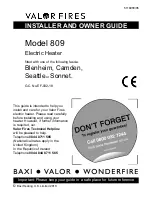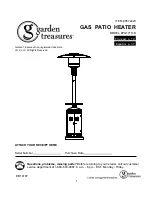
Series Premier VS-VH
Page 59
LT135 Dec 2019
a. Take a firm object (cardboard or metal strip) and when it starts to spark, carefully slide the object over the
opening slowly reducing the air being drafted in.
b. When the flame stabilizes keep the opening restricted that amount. If the adjustment screw was at the correct
starting position you should not have to restrict a big amount of the opening.
c. Adjust the Zero Regulator adjustment screw. Clockwise increases the amount of fuel being supplied to the
burner and counterclockwise will reduce fuel supply.
d. Turn the adjustment screw a 1/4 - 1/2 turn clockwise. Wait 2 – 5 seconds to allow the diaphragm in the
regulator to adjust. The flame should get stronger.
e. Now slowly slide your object back to allow more air in. Just when the flame starts to get unstable again (flutter
and intermittent sparking due to loss of flame signal) turn the adjustment screw another 1/4 – 1/2 turn
clockwise.
f.
Repeat these steps until you are able to completely remove your object and allow full air draw and a nice
stable flame is present. We need to make sure this is as lean as possible.
g. Now that the burner is up and running, turn the adjustment screw a 1/4 turn counterclockwise. After every
1/4 turn wait 5 seconds to allow it to settle. Keep turning it a 1/4 turn at a time with the pauses in between
until the flame once again becomes unstable.
h. Now once it starts fluttering and sparking, turn the screw a 1/2 turn clockwise. This will stabilize the flame.
Now we are sure it is a strong stable flame operating at its leanest.
i.
Just to make sure it is operating properly; the flame sensor should be glowing red. Leave this burner running.
5. Now go to the next burner in line moving away from the burner and repeat all steps. Make sure you adjust
the dip switch settings so this one will not light at the same time as the others.
NOTE:
All burners need adjustment
EXCEPT
burner #1’s. Those are the burners furthest away from the vacuum
pump and closest to the End Vent Cap. Burner #1’s uses fresh air for secondary combustion, so it is very forgiving.
The flame characteristics on this burner are also different from the rest. You will still have to set the dip switch setting
on the burner.
Now your burners are running, wait 1/2 hour with the system heating. Now we can adjust the End Vent Vacuum to
get the proper vacuum designed for your system.
6 – Final Balancing the System Vacuum
1. Turn ON the Gas Supply.
2. Turn up the Thermostat(s) to start the System and let it run (with Burners operating) for at least 30 minutes.
3. With a manometer check the vacuum at the End Vent Cap of the longest Branch. (Refer to Figure 48 for
manometer positioning details.)
4. Adjust the Dampers again (
Caution: dampers are now hot adjust with caution
) as required to obtain the
vacuum readings 0.1 to -0.2 in. W.C. of the settings in Table F. The Burners in this Branch should now
be firing at the appropriate rate.
5. Proceed similarly until each individual Branch in the System is balanced/re-adjusted.
6. Mark the Damper position and lock in place when the System has been balanced. (Lock in place by putting a
screw through the handle to hold it against the Sleeve/Tube.)
7. Turn the Thermostat(s) down again to shut off the System.
NOTE:
An End Vent Vacuum which is intermediate to (between) those shown will result in rates intermediate and
proportional to those which are listed.
NOTE
: Vacuum settings and rates apply regardless of the number of Burners being used in the
system branch to
the maximum allowable number of burners as per Table G.










































